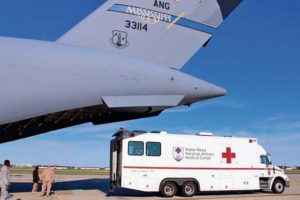
SCOTT AIR FORCE BASE, Ill. — U.S. military C-17 Globemaster III aircraft often arrive at Joint Base Andrews, Maryland, and Travis Air Force Base, California, from foreign locales, transporting cargo, but also at times, ill or injured service members returning stateside for continuing medical treatment.
As the Department of Defense’s single manager for global patient movement, U.S. Transportation Command conducts this lifesaving mission via the U.S. Air Force’s aeromedical evacuation system, which provides in-transit health care for America’s wounded warriors from the point of injury or illness to medical facilities with the level of care needed to properly treat their medical conditions.
From JBA and Travis Air Force Base, some patients, dependent on medical condition and/or service-directed requirements, are subsequently transported to other locations within the continental U.S. to reach the best facility for their particular circumstances.
“On a weekly basis, USTRANSCOM moves up to 40 patients from overseas to CONUS, with a broad set of final medical destinations,” said U.S. Air Force Col. John Andrus, command surgeon, USTRANSCOM. “Just like in our overseas theaters of operation, the weekly movement of DOD patients across the United States involves the USTRANSCOM Patient Movement Requirements Center–Americas, Scott Air Force Base, Illinois, validating the patient(s) and the 618th Air Operations Center (Tanker Airlift Control Center) also at Scott, coordinating the aircraft from JBA or Travis AFB to the final medical treatment destination. When military aircraft are not available, contract air ambulances are used.”
Using a hub (JBA/Travis Air Force Base) and spoke (final definitive care destination(s)) system, the CONUS patient distribution process can manage current workload. Contingency planning and patient movement exercises continue to refine and advance the interagency effort that would be required to accommodate a larger number of ill and injured servicemembers coming back from a large-scale conflict or contingency.
When needed, military, Veterans Affairs’, and National Disaster Medical System hospital beds across the nation are identified through a collaboration between the Departments of Health and Human Services and Homeland Security, as well as the DOD and VA. Patients are assigned and moved to those beds through a hub and spoke transportation system. For example, the Army, Air Force, Navy, and the VA operate over 60 Federal Coordinating Centers, which serve as patient reception hubs and spokes throughout America. This system gives returning wounded warriors access to military, VA, and NDMS beds, as required.
“Established in 1984 and managed by HHS, the NDMS demonstrates a whole-of-government approach in receiving — and treating — large numbers of patients. For instance, during a contingency, such as a hurricane or earthquake, the Federal Emergency Management Agency, which is the lead federal agency, would identify DOD and VA FCCs to support the contingency,” stated U.S. Navy LCDR Liza Soza, U.S. Public Health Service, HHS’ liaison officer, USTRANSCOM’s Command Surgeon Directorate. “Whether in a defense support of civil authorities’ situation or conflict, FCCs serve as a critical component in the CONUS patient distribution system, enabling a coordinated and comprehensive response that enhances our wounded warfighters’ medical treatment, and ultimately, their survivability.”
Annually, the USTRANSCOM-led Ultimate Caduceus command-post and field-training exercise evaluates the command’s capability and capacity to conduct global patient movement in a contingency or conflict, as well as assesses the interoperability across services, government, and interagency partners. This year’s exercise occurs at Wright-Patterson Air Force Base, Ohio, in June, and will feature significant VA participation. The host installation will act as the FCC hub, distributing patients to spoke medical treatment facilities located in nine nearby metropolitan areas.
“As the lead for global patient movement, USTRANSCOM ensures the safe, secure, and sound transport of our nation’s wounded warfighters inside and outside of CONUS,” Andrus said. “Throughout the 24/7 process, our incredible team executes this unique mission with the utmost professionalism, precision, and proficiency, always putting each patient — and their medical care — first and foremost.”
USTRANSCOM exists as a warfighting combatant command to project and sustain military power at a time and place of the nation’s choosing. Powered by dedicated men and women, we underwrite the lethality of the Joint Force, we advance American interests around the globe, and we provide our nation’s leaders with strategic flexibility to select from multiple options, while creating multiple dilemmas for our adversaries.


